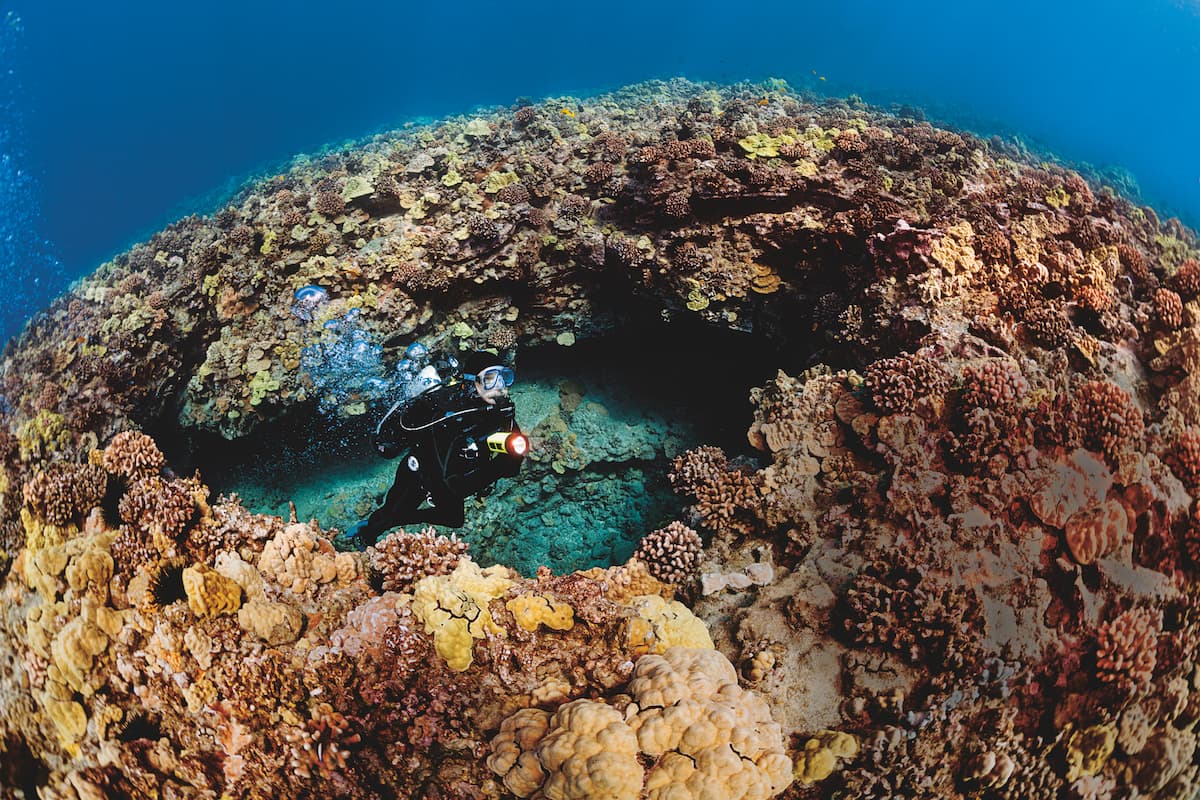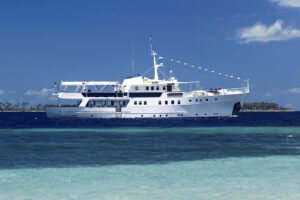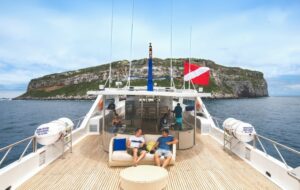Photographs by Michele Westmorland
In the Hawaiian Islands, one goddess reigns supreme. Pele (pronounced ‘pay-lay’) is the goddess of fire, lightning, wind and volcanoes in Hawaiian mythology, and nowhere else does she show her power more vividly and forcefully than on the Big Island of Hawaii.
Pele, according to legend, lives in the Halema’uma’u crater of Kilauea, and when you fly into Kailua-Kona airport you get an extraordinary glimpse of her presence in one of the most active volcanoes in the island chain – and in the world.
There are many myths and stories about Pele, and most Hawaiians claim to have seen her at least once in their life. She is so powerful that she can change her shape and appearance at whim. Maybe she is a dancing plume of fire, smoke and ash. Other times, she appears as an old woman, bent over with age.
I have come to Kona to seek out my own underwater goddess – one that may appear in the form of a beautiful fish, dolphin or manta – and maybe even catch a glimpse of Pele herself.
I will spend the next week onboard the Kona Aggressor II, a liveaboard dive yacht that travels the coast of the Big Island in search of creatures that inspire and amaze. Anxious to see what mysteries await me underwater, I set up my dive gear on the boat’s spacious dive deck, head to my roomy cabin to store my personal items, and assemble my underwater camera system. Once set up and ready to go, I feel my excitement build as our captain and Divemasters tell us about the dive sites we will visit during the week.
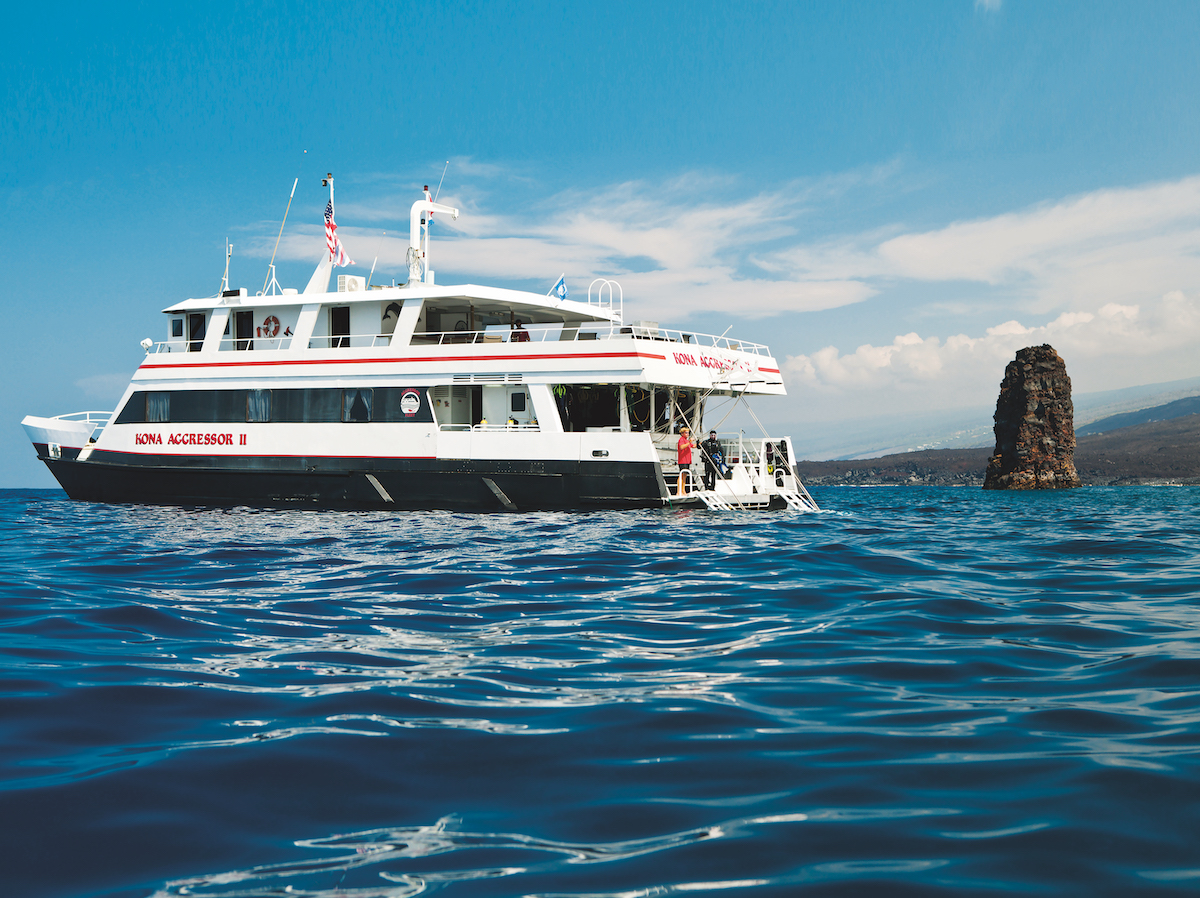
1. The Meadows
We don’t have to travel far from the marina to make our first dive of the trip. The Meadows is a nice secluded spot for our check-out dive, allowing us divers to make sure our gear is working properly and that we are correctly weighted. For me, even more important is making sure my camera equipment is properly set up and there are no dreaded problems!
As we get our bearings in the water, we are treated to a preview of the week ahead, during which we will get an close up look at fish, creatures and corals that can only be seen in these waters.
It is estimated that some 20 percent of the reef fish and 25 percent of the coral species found here are endemic to Hawaii.

2. Kona's Manta Night Dive
The night-time manta dive is one of the most thrilling adventures in Hawaii, and participating in this event comfortably from the Kona Aggressor II is a huge advantage.
Anchored in calm waters, we enjoy a fabulous dinner as we watch the sun go down and other day boats pull in to prepare for the dive. On their menu – packed sandwiches and snacks. On our menu – a lovely salad, grilled skewers of fish and vegetables, and dessert. With plenty of time to let our incredible meal digest, we get our lights, cameras and gear ready to go.
It is a virtual light show at the site. Snorkelers on the surface light ‘the stage’ with their torches, and divers circle around a large underwater light system used to attract small plankton creatures – the mantas’ own dinner menu.
Attracted to this critter soup, the mantas appear from the darkness. Our Aggressor dive team remains on the fringe. Anxious to get closer, we are carefully instructed to be patient – and we will be rewarded. Once the other visitors start to leave, we are ready to move in.
“At depth, we see more than ten large, graceful mantas dancing above our heads, giving us an incredibly memorable performance.”
We are privileged to have these creatures all to ourselves, and they are obviously enjoying themselves, too. As we leave the site, several mantas follow us back to the boat, continuing their dance as they feed under the lights of the Aggressor.
Back on the boat, we all wonder what can possibly top our exciting manta dive for the balance of the week.
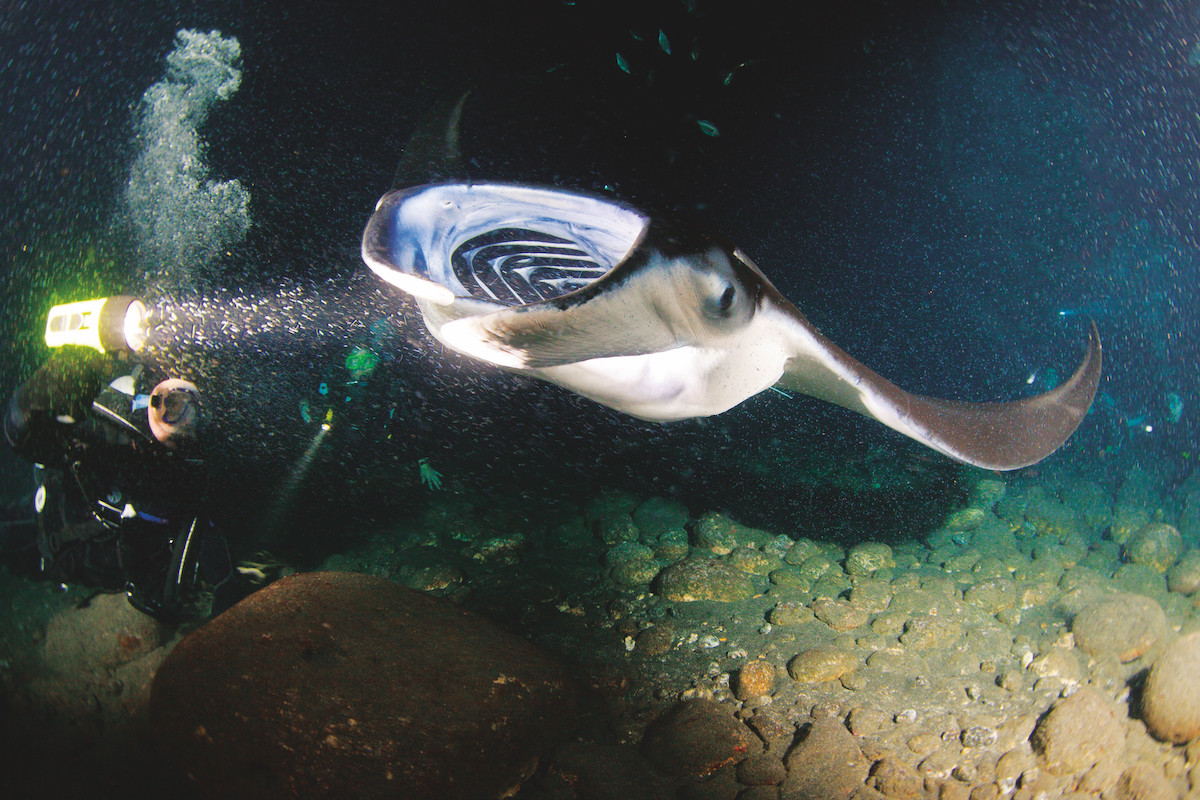
3. West Coast Wonders
The west coast provides all the dive action you need for a wide variety of experiences, from colorful swim-throughs to fascinating lava tubes. The lava formations are, for the most part, blanketed in brilliant red and orange encrusting sponges.
“Overhead light streams in through openings and crevices, where fish hide from the elements – and predators.”
Sites with names like Catacombs, Stoney Mesas and Tubastrea Tunnel are clear indicators of the interesting structures. The sites are visually amazing, but even more striking are the different sounds you hear.
What stood out to me was not the typical crunching of coral by parrotfish, or even the muted calls of the humpback whales during the winter months, but the distinctive whooshing noises of small rocks and boulders being tumbled by the surge.

4. Manuka Bay
Probably my favorite area on the week’s itinerary is Manuka Bay, located midway between the town of Kailua-Kona and the southern tip of the island.
“This quiet refuge is a favorite for spinner dolphins to bring their young calves and rest after a night of hunting in the open ocean.”
They are not always in the bay, but when they are, it is a treat that creates a lasting memory. Because these dolphins do not like the bubbles created from regulators, we leave our scuba tanks on the boat and grab our snorkeling gear.
Clearly, the dolphins love to play with ‘human toys’— at one point, there are more than 40 animals frolicking around us. Babies come close to investigate us, while their mums stay nearby to herd them off if they spend too much time around us.

I watch my friend, who is an excellent swimmer, dive down, twist and turn alongside several beautiful dolphins. But once they become bored with him, they quickly let him know his time is up with a nod and a vocal sound. Seconds later, all that could be seen are tails moving off into the blue.
After so much physical activity, it’s wonderful to get back onboard the Kona Aggressor II and be treated to some of the best meals served on any liveaboard. Grace is an accomplished chef who creates fabulous dishes, such as fish filet on a bed of couscous drizzled with a lovely caper and lemon sauce. We finish each meal with a dessert that would make any pastry chef jealous. How can food of such a high quality be prepared in a little galley on a boat? No wonder our fabulous chef received an award for being the best in the fleet.
As a dive location, Manuka Bay is as memorable as it gets. Just below the boat are rock and hard coral outcroppings in a variety of delightful formations. Several arches make for interesting swim-throughs, but what I find most delightful is a soccer ball-sized frogfish.
He (or she) is a brilliant red, and its chosen site for hunting is right on the wall of one of the arches. Here, I am able to photograph the grumpy-looking fish with every imaginable lens. I start with an 8mm-15mm fisheye lens, which is generally used for very large subjects and landscapes, allowing me to focus within an inch or so and still include some of the scene in the image. Then I move to macro lenses to get a lovely close portrait and to capture facial details.
I am also treated to eels I’ve never seen before. I see dragon and viper morays and a sizable conger out on the hunt, and brilliant blue male boxfish, the peacocks of the reef.
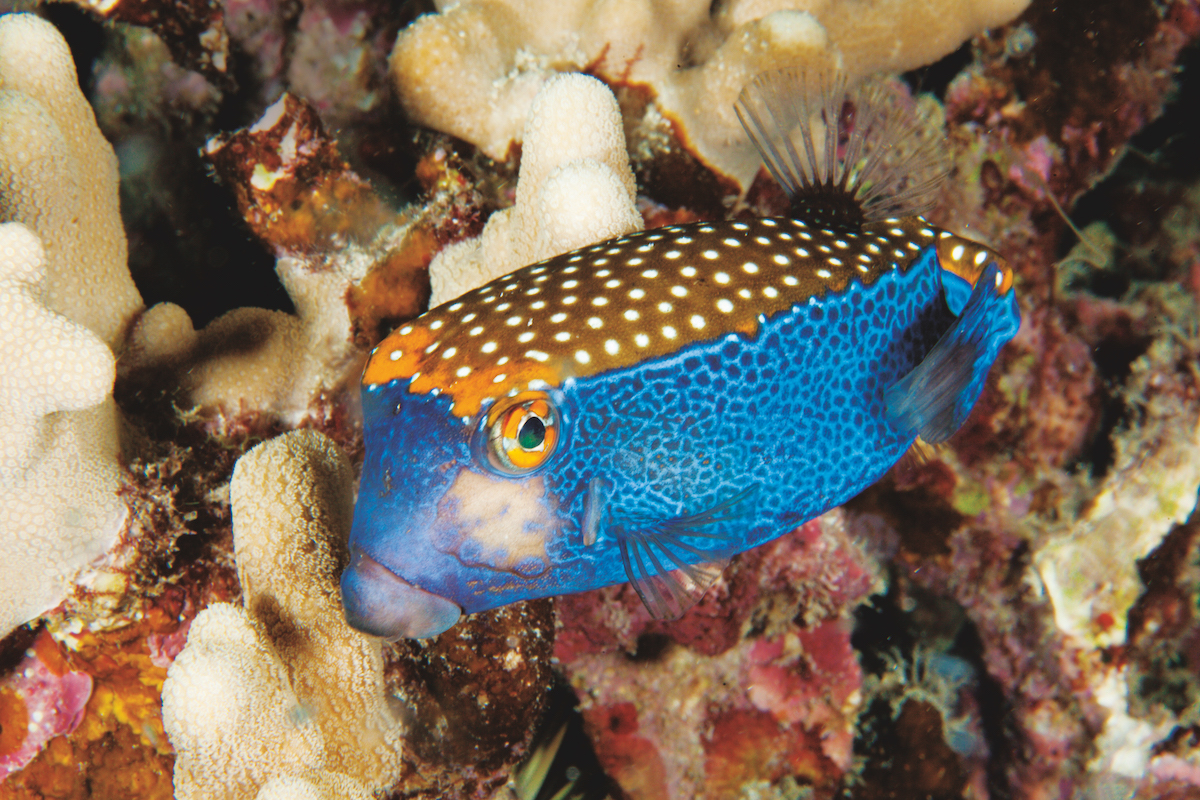
5. Never-Never Land
Our captain navigates north to our next site, Never-Never Land. Here, a large pinnacle protrudes out of the water, but below the surface is a beautiful coral-filled ledge along the crater’s drop-off.
Never-Never Land features plenty of raccoon butterflyfish, but what fascinates me are the juvenile and adult peacock razor wrasses. These small sand-dwellers are not the easiest to photograph, but they are fun to watch as they skip across the bottom searching for morsels of food. I spot a lovely strawberry nudibranch slowly making its way over some rubble.
Off the wall are two larger species of marine life – a lone hammerhead cruising and a slow-moving green sea turtle, oblivious of the apex predator. Down deep, the Divemaster points out two of Hawaii’s most-stunning residents that are found nowhere else in the world – the bandit angel and Tinker’s butterflyfish.

6. Au Au Crater
We move on to a new location, a crew favorite called Au Au Crater. This underwater crater of an extinct volcano is a testament to the power of the Earth’s (and, no doubt, goddess Pele’s) activities.
The walls of this subaquatic basin are decorated with hard corals, fish, and nudibranchs. I also come across a little octopus love – perfect timing as it happens to be Valentine’s Day! And the gorgeous red colors of the reef, thanks to the endemic lionfish and strawberry nudibranchs, only add to the romantic effect.
Romance is also in the air (or water, to be precise) for the humpback whales who call the Hawaiian Islands home this time of year. It’s their calving and breeding season, and the humpback whale songs are so loud that it feels like the creatures must be right on top of us.
However, the fact is that these calls can travel great distances, and many times during the early morning and late afternoon we are treated right to spouting, tail lobbing and occasionally breaching whales.
“Continuing north, our captain, Carl, spots something I’ve never experienced before. It is a group of seven logging hammerhead sharks, resting on the surface of the glass-smooth water.”
Who knows how many are below? According to long-time friend and marine biologist Doug Perrine, this is something that only happens this time of year. The reason is still unknown. We stay right next to them for an unforgettable half hour.

7. Turtle Pinnacle
After a night at the mooring, we venture north to wrap up the trip at Turtle Pinnacle. This is a cleaning station for turtles to be manicured by the local tang population, but they elude us today. I only see one very sleepy giant under the ledge of the pinnacle. However, I do find a little frogfish on the reef, and off the wall I observe a spotted eagle ray casually gliding over the top.
I end the week with precious memories of brand-new sensations and experiences – and a deep appreciation of the goddess Pele in all her many manifestations. If, as legend has it, she can transform herself at will, then I am sure she was diving with us all week, making her presence known among the gliding mantas, playful spinner dolphins, and spectacular humpback whales.
Your Guide to Hawaii Scuba Diving
Kona Aggressor II: Stats and facts
Length: 78 feet
Beam: 28 feet
Cruising Speed: 10 knots
Range: 1,200 nautical miles
Builder: Nichols Brothers, Whidbey Island, Washington
Staterooms: Six
Passengers: 14
With the new carpet, couches and other touches, it made me feel like I was in the living room of my own home. The deluxe cabins are roomy enough and easily accessible from inside the salon area – no more damp feet by treading on an exterior walkway.
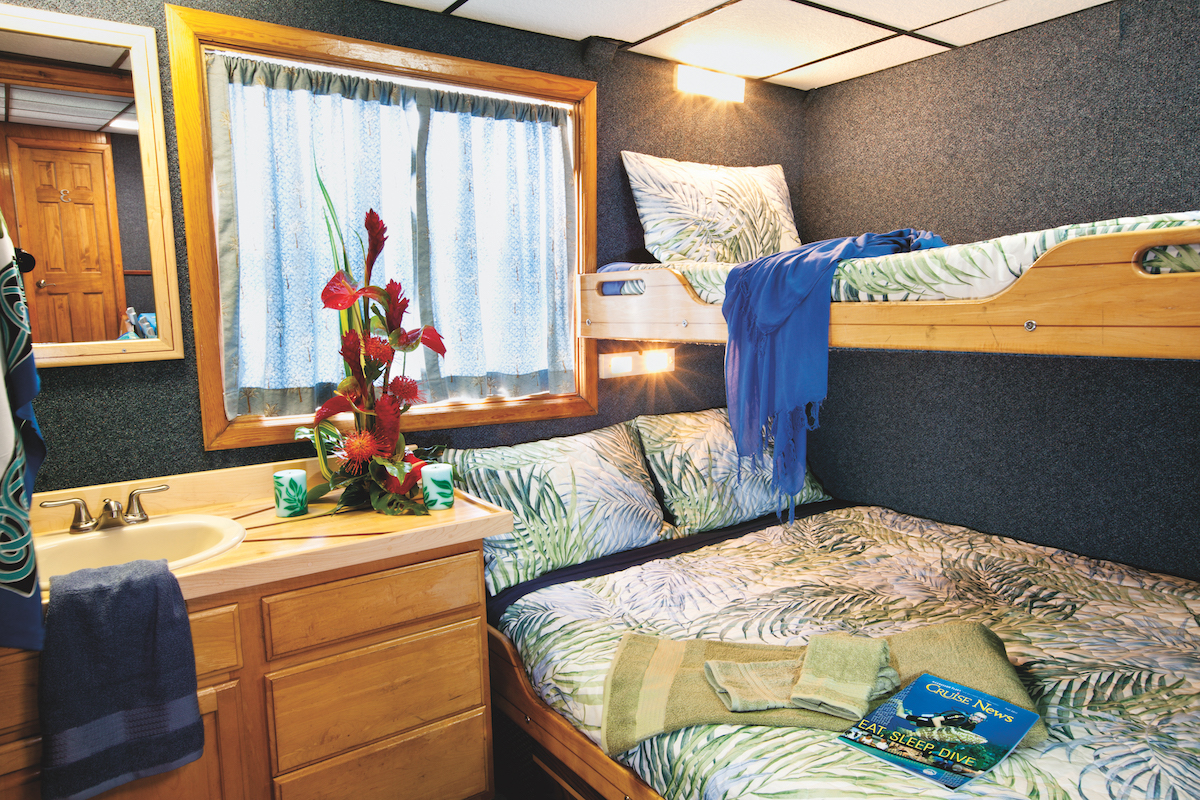
There is a quad stateroom that was shared by a lovely family. The two young ladies, ages 10 and 11, received their PADI Junior Open Water Diver certification through the caring instructors on board the boat. Talk about lucky young ladies! Both the crew and the guests were delighted in sharing their first underwater adventure. Great job by the crew and instructor for making it fun – and safe!
In the main story, I’ve already mentioned the food. I’ll mention it again – it was no doubt some of the best I’ve had anywhere.
Visit Aggressor Adventures to find out more.
Volcano National Park
Rent a car and drive to the volcano. The landscape changes dramatically from the rocky shoreline into the vast lava fields with steaming vents from the active volcano. If you are lucky, you may even see some action from molten hot lava flowing from a couple of locations. Contact the park service for information on the activity.
Did you know?
Hawaii produces one third of the entire world’s commercial pineapples!
